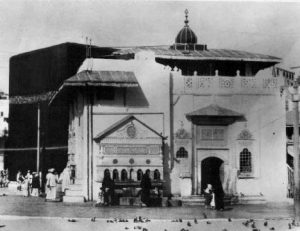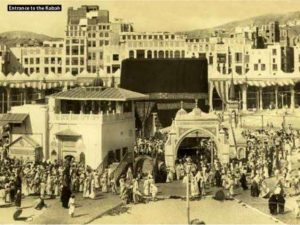
Pilgrims would gather in capital cities of Syria, Egypt, and Iraq to go to Makkah in groups and caravans comprising tens of thousands of pilgrims.
Muslim rulers who served pilgrims
Pilgrims would gather in capital cities of Syria, Egypt, and Iraq to go to Makkah in groups and caravans comprising tens of thousands of pilgrims.[8] The responsibility of providing state patronage for organizing such pilgrimage caravans was given to commanders known as Umara’ al-Hajj, who were in charge of protecting the pilgrims and securing funds and supplies for the journey.[9]
Haaroon Ar-Rasheed — the Caliph who was said to fight in Allah’s cause one year and perform Hajj the next alternately — was a great patron of scholars and erected a shade for scholars on the roof of Al-Masjid al-Haraam.
His wife Zubaydah bint Ja’far, had a 900-mile road constructed from Koofah to Makkah called Darb Zubaydah (Zubaydah’s Road) in 780 C.E., which was one of the earliest routes created specifically for pilgrims. Being particularly concerned about poorer pilgrims who traveled on foot, she added nine new rest stations at convenient intervals between existing stations, for a total of fifty-four rest stops. All the new stations included a pool, some kind of shelter and sometimes even a small mosque.[10]
Having witnessed the plight of poor pilgrims, who had to pay a dirham for a small bottle of water, she had a series of wells and channels dug along the Hajj route from Wadi Nu’man to Makkah. These wells, called ‘Ayn Zubaydah, were built at an estimated cost of 54 million dirhams, parts of which can be seen even today. Ibn Jubayr who traveled from Andalusia to Makkah, recorded:
“The pilgrims poured out the water they had and took of this good water, rejoicing at its abundance. The people took joy in swimming and bathing in it and washing their garments. It was for them a day of rest upon the journey, a gift bestowed by God.”[11]
Generosity of Non-Arab rulers
In 1324 C.E., a devout Muslim ruler from Mali called Mansa Musa set out on his first Hajj to Makkah with a hundred camels each laden with 300 pounds of gold, food and clothing and accompanied by 60,000 people including officials, soldiers, doctors, teachers, and storytellers.[12] They made their way from the capital Niani to Timbuktu, across the Sahara Desert and Cairo before reaching Arabia, where it is said people lined the streets to catch a glimpse of him and his elaborate entourage.

Muslim rulers over the years took care to honor the Ka‘bah and its pilgrims.
Upon completing his pilgrimage, Mansa Musa gave away money and gold to the residents of both Makkah and Cairo — so much so that its value in the Middle East dropped drastically!
Another historic Hajj journey was that of Sikandar Begum, ruler of a princely state called Bhopal in India who reached Jeddah on 23 January, 1864 , being the first ever ruler from the Indian subcontinent to perform Hajj. She maintained a detailed diary describing everything she saw — seven-store houses in Jeddah, the marketplace and even the taste of the town’s “brackish water”.
Her journey from Jeddah to Makkah could have ended disastrously, as the Begum’s reputation as a rich, generous ruler had preceded her, “coupled with her regrettable habit of throwing currency notes from her carriage…”[13]
She was among the first rulers to acquire land in Makkah and Madinah and buildrubats (lodgings) that she bequeathed as charitable endowments for the benefit of pilgrims from her state, which are in use even today. The rulers of other princely states in India such as Hyderabad, Arcot and Tonk followed suit.
Today, with nearly 3 million pilgrims to provide for, the logistics of organizing Hajj are mindboggling and extend beyond food, water, shelter and a safe route to 24-hour health services and shopping malls, plush hotels, e-services and personalized apps.
What’s worth remembering is that even if the means by which we serve pilgrims are different, the spirit must remain the same: aiming at pleasing Allah by making the path of His servants easy; not seeking commercial gains or personal profit. As the Prophetic narration goes: “Actions are but by intentions and every man will have only what he intended.”[14]
[1]In the past, people traveled by land over long stretches of inhospitable terrain, often faced by hostile people. The Arab greeting ‘ahlan wa sahlan’ means: “You are among hospitable people (i.e., people that are almost like family to you and are treading smooth and flat terrain”. Often, people add the words: “wa marhaban” derived from the Arabic root word rahuba, which means being spacious and wide, as opposed to feeling straitened.
http://lisanularab.blogspot.com/2007/10/assalamu-alaykum-warahmatullahi.html
[2] Muhammad: His Life Based on the Earliest Sources, Martin Lings
[3] Homes of Old Makkah, Nihal Uluengin, Bülent Uluengin.
[4] Shams al-Din Abu ‘Abd Allah al-Muqaddisi
[5] Journeys of Faith, Roads of Civilization, David W. Tschanz
[6] Journeys of Faith, Roads of Civilization, David W. Tschanz
[7] Homes of Old Makkah, Nihal Uluengin, Bülent Uluengin.
[8] The Hajj: The Muslim Pilgrimage to Mecca and the Holy Places, F. E Peters
[9] The Hajj: The Muslim Pilgrimage to Mecca and the Holy Places, F. E Peters
[10] Voyages of World History, Valerie Hansen, Ken Curtis
[11] Rihla, Ibn Jubayr
[12] Mansa Musa: Ruler of Ancient Mali, Peggy Pancella
[13] The Begums of Bhopal, Shaharyar M. Khan
[14] Sahîh al-Bukhârî and Sahîh Muslim
First published, September 2016
Pages: 1 2